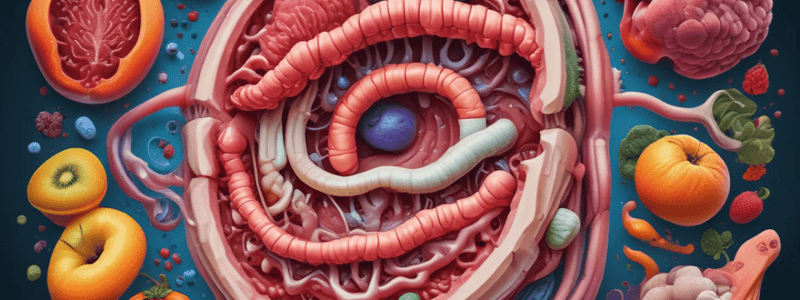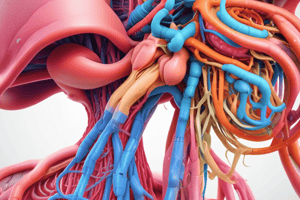Podcast
Questions and Answers
What is the primary function of the receptive relaxation of the stomach?
What is the primary function of the receptive relaxation of the stomach?
- To increase the pressure in the stomach to facilitate digestion
- To stimulate the pyloric pump
- To increase the rate of stomach emptying
- To accommodate food with minimal increase in pressure (correct)
What is the main factor that determines the rate of stomach emptying for liquids?
What is the main factor that determines the rate of stomach emptying for liquids?
- The presence of gastrin
- The volume of the liquid (correct)
- The acidity of the gastric juice
- The strength of the pyloric pump contractions
What is the primary function of the hunger contractions (pangs) that begin 12-24 hours post-prandially?
What is the primary function of the hunger contractions (pangs) that begin 12-24 hours post-prandially?
- To stimulate the secretion of gastric juice
- To signal the body that it is time to eat again (correct)
- To increase the tone of the pyloric sphincter
- To initiate the process of gastric emptying
What is a role of gastrin in the regulation of stomach emptying?
What is a role of gastrin in the regulation of stomach emptying?
What is the primary mechanism by which the duodenum inhibits the rate of stomach emptying?
What is the primary mechanism by which the duodenum inhibits the rate of stomach emptying?
What is the first major process in the assimilation of nutrients?
What is the first major process in the assimilation of nutrients?
What is the process of chewing food called?
What is the process of chewing food called?
Which sphincter is responsible for preventing the backflow of stomach contents into the esophagus?
Which sphincter is responsible for preventing the backflow of stomach contents into the esophagus?
Which of the following is NOT a motor function of the stomach?
Which of the following is NOT a motor function of the stomach?
What is the name of the valve that separates the small intestine from the large intestine?
What is the name of the valve that separates the small intestine from the large intestine?
What is the main function of the colon related to the absorption of water and electrolytes from chyme?
What is the main function of the colon related to the absorption of water and electrolytes from chyme?
What stimulates mass movements that force feces into the rectum?
What stimulates mass movements that force feces into the rectum?
Which part of the colon is responsible for slowly digging into and rolling over fecal matter?
Which part of the colon is responsible for slowly digging into and rolling over fecal matter?
What muscle controls the dribble of fecal matter through the anus?
What muscle controls the dribble of fecal matter through the anus?
When do mass movements, such as propulsive movements, usually occur?
When do mass movements, such as propulsive movements, usually occur?
What reflex must fortify the weak intrinsic myenteric reflex for effective defecation?
What reflex must fortify the weak intrinsic myenteric reflex for effective defecation?
Which structure plays a critical role in determining if a bolus of food is small enough to be safely swallowed?
Which structure plays a critical role in determining if a bolus of food is small enough to be safely swallowed?
What happens due to the signaling between the pharynx and the swallowing center in the brainstem?
What happens due to the signaling between the pharynx and the swallowing center in the brainstem?
Which factor can inhibit gastric emptying according to the text?
Which factor can inhibit gastric emptying according to the text?
What is the purpose of the ileocecal valve according to the text?
What is the purpose of the ileocecal valve according to the text?
What are functions of the mucosal muscle according to the text?
What are functions of the mucosal muscle according to the text?
Which of the following can affect intestinal motility?
Which of the following can affect intestinal motility?
Mass movements can lead to bowel movements.
Mass movements can lead to bowel movements.
The epiglottis is critical for determining whether a bolus of food is small enough to be swallowed safely.
The epiglottis is critical for determining whether a bolus of food is small enough to be swallowed safely.
The lower esophageal sphincter is the main concern for the risk of aspiration when a patient feels food from the night before sitting in their stomach just before induction.
The lower esophageal sphincter is the main concern for the risk of aspiration when a patient feels food from the night before sitting in their stomach just before induction.
Administering glycopyrrolate increases barrier pressure and decreases the likelihood of aspiration.
Administering glycopyrrolate increases barrier pressure and decreases the likelihood of aspiration.
Swallowing is a simple reflex that does not involve signaling between the pharynx and the swallowing center in the brainstem.
Swallowing is a simple reflex that does not involve signaling between the pharynx and the swallowing center in the brainstem.
Mass movements usually occur when the stomach is empty, approximately 12-24 hours after a meal.
Mass movements usually occur when the stomach is empty, approximately 12-24 hours after a meal.
The ileocecal valve is responsible for slowly digging into and rolling over fecal matter in the colon.
The ileocecal valve is responsible for slowly digging into and rolling over fecal matter in the colon.
Gastrin is the primary factor that inhibits gastric emptying.
Gastrin is the primary factor that inhibits gastric emptying.
Study Notes
Propulsion and Mixing of Food in the Alimentary Tract
- Ingestion of Food:
- Mastication: chewing breaks down food into smaller particles, increasing surface area for enzymatic digestion
- Deglutition: swallowing involves signaling between pharynx and swallowing center in brain stem
- Motor Functions of the Stomach:
- Receptive Relaxation: vagally mediated, triggered by movement of pharynx and esophagus, allowing stomach to accommodate food
- Mixing and Emptying: stomach mixes food with acid and enzymes, then empties into duodenum at a rate suitable for digestion
- Regulation of Stomach Emptying:
- Factors Promoting Emptying: stretching stomach wall, gastrin, and insulin stimulate emptying
- Factors Inhibiting Emptying: duodenal distension, CCK, and irritants can inhibit emptying
Movements of the Small Intestine
- Segmentation Movements: "chop" chyme into smaller particles
- Peristalsis: propels chyme through small intestine
- Migrating Motor Complexes (MMCs): interrupt peristalsis at 90-minute intervals to move indigestible components through small intestine
Movements of the Colon
- Mixing Movements - Haustrations: slow movement of fecal matter exposing it to mucosal surface
- Mass Movements: propulsive movements stimulated by gastrocolic and duodenocolic reflexes, occurring 1-3 times a day
- Defecation: rectum is usually empty of feces; internal and external anal sphincters regulate defecation
Sphincters and Reflexes
- Ileocecal Valve: prevents backflow from colon to small intestine
- Lower Esophageal Sphincter: relaxation is critical for determining whether a bolus of food is small enough to be swallowed
- Gastrocolic and Duodenocolic Reflexes: stimulate mass movements in the colon
Clinical Relevance
- Aspiration Risk: lower esophageal sphincter relaxation is a concern for aspiration risk
- Barrier Pressure: increasing barrier pressure can decrease the likelihood of aspiration
Studying That Suits You
Use AI to generate personalized quizzes and flashcards to suit your learning preferences.



